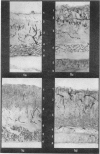Abstract
The vascular response in tuberculin hypersensitized rats and guinea-pigs, each bearing lesions of one age only, was measured in the rats in terms of migration of leucocytes and in both species, in terms of exudation of protein and labelling of the affected vessels by circulating carbon.
Migration of inflammatory cells, in the rat differed in distribution within the dermis from that in the guinea-pig, being confined to the hypodermal and pannicular vessels throughout the time-course. In the guinea-pig the upper dermal vessels are commonly involved from the early stages of the delayed phase. The time-course of migration of rat PMN cells with a maximum in lesions 4·5 hours old, differed from that in the guinea-pig at 8 hours. Similarly the time of maximum monocytic migration at 16 hours compares with that in the guinea-pig at 20 hours. In both species migration was greatest in middle sized and smaller venules.
It was confirmed that the permeability and labelling responses in the two species are biphasic, but the immediate phase in the rat proved to be nonspecific. In the guinea-pig the immediate phase of labelling was specific at the dose (1·0 unit) of tuberculin used but not that of exudation. The delayed phase of both exudation and labelling in rat was maximal at 16 hours and in the guinea-pig at 20 hours.
Exudation during the delayed phase in both species was always clearly defined and roughly proportional (in the rat) to the log dose of challenge, but the corresponding phase of maximum capillary labelling in the rat was very short-lived, and occasionally absent, whereas in all guinea-pigs it lasted from 10 to at least 38 hours. In addition to the two main phases there was in 1/4 rats and in 5/8 guinea-pigs evidence of an intermediate phase of exudation at 2 to 6 hours and of labelling in 1/4 rats and 1/3 guinea-pigs at 6 hours. Both the immediate and intermediate phases of the reactions were characterized by venular labelling, but in the delayed phase capillary labelling predominated in both species. The reality of this labelling in the rat was confirmed in tests with graded doses of tuberculin up to 10 times that used for the main study, which confirmed that it was proportional to the log dose. Venular labelling in the delayed phase was usually negligible in the rat, and in the guinea-pig it was up to 15% in 1/12 hypersensitive animals examined between 10 and 38 hours but also 19% in one control at 38 hours.
In both the rat and guinea-pig there is a close parallelism between the peak of active mononuclear cell migration and that of exudation in the delayed phase, again suggesting that the two may be directly interrelated.
Full text
PDF












Images in this article
Selected References
These references are in PubMed. This may not be the complete list of references from this article.
- ARNASON B. G., WAKSMAN B. H. TUBERCULIN SENSITIVITY. IMMUNOLOGIC CONSIDERATIONS. Bibl Tuberc. 1964;19:1–97. [PubMed] [Google Scholar]
- BOUGHTON B., SPECTOR W. G. Histology of the tuberculin reaction in guinea-pigs. J Pathol Bacteriol. 1963 Apr;85:371–381. doi: 10.1002/path.1700850215. [DOI] [PubMed] [Google Scholar]
- Baumgarten A., Wilhelm D. L. Vascular permeability responses in hypersensitivity. I. The tuberculin reaction. Pathology. 1969 Oct;1(4):301–315. doi: 10.3109/00313026909071310. [DOI] [PubMed] [Google Scholar]
- Bosman C., Feldman J. D. Composition, morphology, and source of cells in delayed skin reactions. Am J Pathol. 1970 Feb;58(2):201–218. [PMC free article] [PubMed] [Google Scholar]
- FLAX M. H., WAKSMAN B. H. Delayed cutaneous reactions in the rat. J Immunol. 1962 Oct;89:496–504. [PubMed] [Google Scholar]
- Humphrey J. H. Cell-mediated immunity--general perspectives. Br Med Bull. 1967 Jan;23(1):93–97. doi: 10.1093/oxfordjournals.bmb.a070525. [DOI] [PubMed] [Google Scholar]
- INDERBITZIN T. The effect of acute and delayed cutaneous allergic reactions on the amount of histamine in the skin. Int Arch Allergy Appl Immunol. 1955;7(3):140–148. doi: 10.1159/000228221. [DOI] [PubMed] [Google Scholar]
- KOLIN A., JOHANOVSKY J., PEKAREK J. HISTOLOGICAL MANIFESTATIONS OF CELLULAR (DELAYED) HYPERSENSITIVITY. I. ALTERATIVE COMPONENT IN TUBERCULIN SKIN REACTION IN GUINEA-PIGS. Z Immunitats Allergieforsch. 1965 Feb;128:117–129. [PubMed] [Google Scholar]
- MILES A. A., MILES E. M. Vascular reactions to histamine, histamine-liberator and leukotaxine in the skin of guinea-pigs. J Physiol. 1952 Oct;118(2):228–257. doi: 10.1113/jphysiol.1952.sp004789. [DOI] [PMC free article] [PubMed] [Google Scholar]
- UHR J. W., PAPPENHEIMER A. M., Jr Delayed hypersensitivity. III. Specific desensitization of guinea pigs sensitized to protein antigens. J Exp Med. 1958 Dec 1;108(6):891–904. doi: 10.1084/jem.108.6.891. [DOI] [PMC free article] [PubMed] [Google Scholar]
- VOISIN G. A., TOULLET F. [Studies on hypersensitivity. I. Demonstration and description of an increase of vascular permeability in the tuberculin hypersensitivity reactions]. Ann Inst Pasteur (Paris) 1963 Feb;104:169–196. [PubMed] [Google Scholar]
- Wiener J., Lattes R. G., Spiro D. An electron microscopic study of leukocyte emigration and vascular permeability in tuberculin sensitivity. Am J Pathol. 1967 Mar;50(3):485–521. [PMC free article] [PubMed] [Google Scholar]
- Willoughby D. A. The mechanism of cutaneous hypersensitivity in the rat and its suppression by immunological methods. J Pathol Bacteriol. 1966 Jul;92(1):139–150. doi: 10.1002/path.1700920115. [DOI] [PubMed] [Google Scholar]



